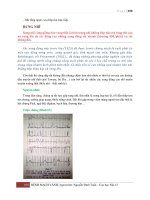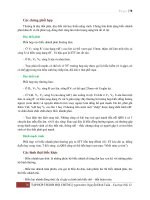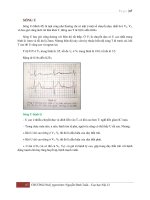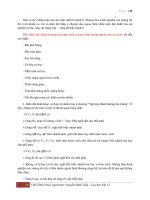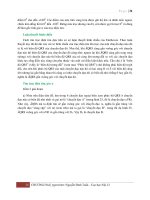test đọc điện tim loạn nhịp
Bạn đang xem bản rút gọn của tài liệu. Xem và tải ngay bản đầy đủ của tài liệu tại đây (943.78 KB, 30 trang )
TEST ®äc ®iÖn
TEST ®äc ®iÖn
tim
tim
lo¹n nhÞp
lo¹n nhÞp
Khoa HSCC BÖnh viÖn E Hµ Néi
Khoa HSCC BÖnh viÖn E Hµ Néi
•
1st Degree AV Block
1st Degree AV Block
The normal PR interval is 0.12 - 0.20 sec, or 120 -to- 200 ms. 1st degree AV block is
The normal PR interval is 0.12 - 0.20 sec, or 120 -to- 200 ms. 1st degree AV block is
defined by PR intervals greater than 200 ms. This may be caused by drugs, such as
defined by PR intervals greater than 200 ms. This may be caused by drugs, such as
digoxin; excessive vagal tone; ischemia; or intrinsic disease in the AV junction or
digoxin; excessive vagal tone; ischemia; or intrinsic disease in the AV junction or
bundle branch system
bundle branch system
•
2nd Degree AV Block, Type I, With Accelerated Junctional
2nd Degree AV Block, Type I, With Accelerated Junctional
Escapes and a Ladder Diagram
Escapes and a Ladder Diagram
The ladder diagram illustrates a Wenckebach type AV block by the increasing PR
The ladder diagram illustrates a Wenckebach type AV block by the increasing PR
intervals before the blocked P wave. After the blocked P wave, however, a rev-ed up
intervals before the blocked P wave. After the blocked P wave, however, a rev-ed up
junctional pacemaker terminates the pause. Note that the junctional beats have a
junctional pacemaker terminates the pause. Note that the junctional beats have a
slightly different QRS morphology from the sinus beats making them more easily
slightly different QRS morphology from the sinus beats making them more easily
recognized. Note also the AV dissociation that accompanies the junctional beats
recognized. Note also the AV dissociation that accompanies the junctional beats
•
2nd Degree AV Block With Junctional Escapes And
2nd Degree AV Block With Junctional Escapes And
Captures-KH
Captures-KH
Second degree AV block is present; conducted beats are identified by those QRS's that
Second degree AV block is present; conducted beats are identified by those QRS's that
terminate shorter cycles than the junctional escape cycle; i.e., the 3rd and probably the
terminate shorter cycles than the junctional escape cycle; i.e., the 3rd and probably the
4th QRS's are captures; the other QRS's are junctional escapes
4th QRS's are captures; the other QRS's are junctional escapes
•
2nd Degree AV Block, Type I
2nd Degree AV Block, Type I
The 3 rules of "classic AV Wenckebach" are: 1. decreasing RR intervals
The 3 rules of "classic AV Wenckebach" are: 1. decreasing RR intervals
until pause; 2. the pause is less than preceding 2 RR intervals; and 3. the
until pause; 2. the pause is less than preceding 2 RR intervals; and 3. the
RR interval after the pause is greater than the RR interval just prior to
RR interval after the pause is greater than the RR interval just prior to
pause. Unfortunately, there are many examples of atypical forms of
pause. Unfortunately, there are many examples of atypical forms of
Wenckebach where these rules don't hold
Wenckebach where these rules don't hold
•
2nd Degree AV Block, Type I (Wenckebach)-KH
2nd Degree AV Block, Type I (Wenckebach)-KH
•
2nd Degree AV Block, Type I With Escapes and
2nd Degree AV Block, Type I With Escapes and
Captures
Captures
Often in the setting of 2nd degree AV block the pauses caused by nonconducted P
Often in the setting of 2nd degree AV block the pauses caused by nonconducted P
waves are long enough to enable escape pacemakers from the junction or ventricles to
waves are long enough to enable escape pacemakers from the junction or ventricles to
take over. This example illustrates junctional escapes, labled 'E' and captures, labled
take over. This example illustrates junctional escapes, labled 'E' and captures, labled
'C'. Note that the PR intevals for the captures vary, making this Type I 2nd degree AV
'C'. Note that the PR intevals for the captures vary, making this Type I 2nd degree AV
block. AV dissociation is seen when the escape beats occur
block. AV dissociation is seen when the escape beats occur
•
2nd Degree AV Block, Type I, with Junctional Escapes
2nd Degree AV Block, Type I, with Junctional Escapes
Junctional escapes are passive, protective events whenever the heart rate slows below
Junctional escapes are passive, protective events whenever the heart rate slows below
that of the escape mechanism. In this example of 2nd degree AV block, type I, the
that of the escape mechanism. In this example of 2nd degree AV block, type I, the
escapes occur following the non-conducted P waves. Arrows indicate the position of
escapes occur following the non-conducted P waves. Arrows indicate the position of
the P waves. Note that the escape beats have a slightly different QRS morphology than
the P waves. Note that the escape beats have a slightly different QRS morphology than
the conducted sinus beats
the conducted sinus beats
•
3rd Degree AV Block Rx'ed With a Ventricular
3rd Degree AV Block Rx'ed With a Ventricular
Pacemaker
Pacemaker
In 'A' the ECG shows complete or 3rd degree AV block with a left ventricular escape
In 'A' the ECG shows complete or 3rd degree AV block with a left ventricular escape
rhythm, as evidenced by the upright QRS morphology. In 'B' the artificial right
rhythm, as evidenced by the upright QRS morphology. In 'B' the artificial right
ventricular pacemaker rhythm is shown
ventricular pacemaker rhythm is shown
•
Atrial Echos-KH
Atrial Echos-KH
In this example a typical Wenckebach sequence is interrupted by what looks like a PAC
In this example a typical Wenckebach sequence is interrupted by what looks like a PAC
- indicated by red arrows. Atrial echos are more likely, however, because the preceding
- indicated by red arrows. Atrial echos are more likely, however, because the preceding
beat has a long PR interval, a condition that facilitates reentry and echo formation
beat has a long PR interval, a condition that facilitates reentry and echo formation
•
AV Dissociation by Default
AV Dissociation by Default
If the sinus node slows too much a junctional escape pacemaker may take over as
If the sinus node slows too much a junctional escape pacemaker may take over as
indicated by arrows. AV dissociation is incomplete, since the sinus node speeds up and
indicated by arrows. AV dissociation is incomplete, since the sinus node speeds up and
recaptures the entricles
recaptures the entricles
•
AV Dissociation by Default
AV Dissociation by Default
The nonconducted PAC's set up a long pause which is terminated by ventricular
The nonconducted PAC's set up a long pause which is terminated by ventricular
escapes; note the wider QRS morphology of the escape beats indicating their
escapes; note the wider QRS morphology of the escape beats indicating their
ventricular origin. Incomplete AV dissociation occurs during the escape beats, since the
ventricular origin. Incomplete AV dissociation occurs during the escape beats, since the
atria are still under the control of the sinus node
atria are still under the control of the sinus node
•
AV Dissociation by Usurpation
AV Dissociation by Usurpation
Normal sinus rhythm is interrupted by an accelerated ventricular rhythm whose rate is
Normal sinus rhythm is interrupted by an accelerated ventricular rhythm whose rate is
slightly faster than the sinus rhythm. Fusion QRS complexes occur whenever the sinus
slightly faster than the sinus rhythm. Fusion QRS complexes occur whenever the sinus
impulse enters the ventricles at the same time the ectopic ventricular focus initiates its
impulse enters the ventricles at the same time the ectopic ventricular focus initiates its
depolarization
depolarization
•
Complete AV Block, Junctional Escape Rhythm, and
Complete AV Block, Junctional Escape Rhythm, and
Ventriculophasic Sinus Arrhythmia
Ventriculophasic Sinus Arrhythmia
Complete AV block is seen as evidenced by the AV dissociation. A junctional escape
Complete AV block is seen as evidenced by the AV dissociation. A junctional escape
rhythm sets the ventricular rate at 45 bpm. The PP intervals vary because of
rhythm sets the ventricular rate at 45 bpm. The PP intervals vary because of
ventriculophasic sinus arrhythmia; this is defined when the PP interval that includes a
ventriculophasic sinus arrhythmia; this is defined when the PP interval that includes a
QRS is shorter than a PP interval that excludes a QRS. The QRS generates a strong
QRS is shorter than a PP interval that excludes a QRS. The QRS generates a strong
enough pulse to activate the carotid sinus mechanism which slows the subsequent PP
enough pulse to activate the carotid sinus mechanism which slows the subsequent PP
interval
interval
•
Complete AV Block (3rd Degree) with Junctional
Complete AV Block (3rd Degree) with Junctional
Rhythm-KH
Rhythm-KH
•
ECG Of The Century: A Most Unusual 1st Degree AV Block
ECG Of The Century: A Most Unusual 1st Degree AV Block
On Day 1, at a heart rate of 103 bpm the P waves are not clearly defined suggesting an
On Day 1, at a heart rate of 103 bpm the P waves are not clearly defined suggesting an
accelerated junctional rhythm. However, on Day 2, at a slightly slower heart rate the
accelerated junctional rhythm. However, on Day 2, at a slightly slower heart rate the
sinus P wave suddenly appears immediately after the QRS complex. In retrospect, the
sinus P wave suddenly appears immediately after the QRS complex. In retrospect, the
sinus P wave in Day 1 was found burried in the preceding QRS; note the notch on the
sinus P wave in Day 1 was found burried in the preceding QRS; note the notch on the
downstroke of the QRS. On Day 3 a normal PR interval was seen. How long can the PR
downstroke of the QRS. On Day 3 a normal PR interval was seen. How long can the PR
interval get in 1st degree AV block??? No one knows.
interval get in 1st degree AV block??? No one knows.
•
ECG Of The Century - Part II: Dual AV Pathways
ECG Of The Century - Part II: Dual AV Pathways
An astute cardiology fellow, yours truly, went to the patient's bedside on Day 2 and
An astute cardiology fellow, yours truly, went to the patient's bedside on Day 2 and
massaged the right carotid sinus as indicated by the arrow. Four beats later at a slightly
massaged the right carotid sinus as indicated by the arrow. Four beats later at a slightly
slower heart rate the PR interval suddenly normalized suggesting an abrupt change
slower heart rate the PR interval suddenly normalized suggesting an abrupt change
from a slow AV nodal pathway to a fast AV nodal pathway, demonstrating the existance
from a slow AV nodal pathway to a fast AV nodal pathway, demonstrating the existance
of dual AV pathways.
of dual AV pathways.
First Degree AV Block - Marquette-KH
First Degree AV Block - Marquette-KH
•
Incomplete AV Dissociation Due To 2nd Degree AV Block
Incomplete AV Dissociation Due To 2nd Degree AV Block
2nd degree AV block is evident from the nonconducted P waves. Junctional escapes,
2nd degree AV block is evident from the nonconducted P waves. Junctional escapes,
labled 'J', terminate the long pauses because that's the purpose of escape
labled 'J', terminate the long pauses because that's the purpose of escape
pacemakers to protect us from too slow heart rates. All QRS's with shorter RR
pacemakers to protect us from too slow heart rates. All QRS's with shorter RR
intervals are capture beats, labled 'c'. Atypical RBBB with a qR pattern suggests a
intervals are capture beats, labled 'c'. Atypical RBBB with a qR pattern suggests a
septal MI
septal MI
•
Isochronic Ventricular Rhythm
Isochronic Ventricular Rhythm
An isochronic ventricular rhythm is also called an accelerated ventricular rhythm
An isochronic ventricular rhythm is also called an accelerated ventricular rhythm
because it represents an active ventricular focus (i.e.not an escape rhythm). This
because it represents an active ventricular focus (i.e.not an escape rhythm). This
arrhythmia is a common reperfusion arrhythmia in acute MI patients. It often begins and
arrhythmia is a common reperfusion arrhythmia in acute MI patients. It often begins and
ends with fusion beats and there is AV dissociation. Treatment is usually not necessary
ends with fusion beats and there is AV dissociation. Treatment is usually not necessary
because the arrhythmia is self-limiting.
because the arrhythmia is self-limiting.
•
LBBB and 2nd degree AV Block, Mobitz Type II
LBBB and 2nd degree AV Block, Mobitz Type II
Mobitz II 2nd degree AV block is usually a sign of bilateral bundle branch disease. One
Mobitz II 2nd degree AV block is usually a sign of bilateral bundle branch disease. One
of the two bundle branches should be completely blocked; in this example the left
of the two bundle branches should be completely blocked; in this example the left
bundle is blocked. The nonconducted sinus P waves are most likely blocked in the right
bundle is blocked. The nonconducted sinus P waves are most likely blocked in the right
bundle which exhibits 2nd degree block. Although unlikely, it is possible that the P
bundle which exhibits 2nd degree block. Although unlikely, it is possible that the P
waves are blocked somewhere in the AV junction such as the His bundle
waves are blocked somewhere in the AV junction such as the His bundle
•
LBBB and 2nd degree AV Block, Mobitz Type II
LBBB and 2nd degree AV Block, Mobitz Type II
Mobitz II 2nd degree AV block is usually a sign of bilateral bundle branch disease. One
Mobitz II 2nd degree AV block is usually a sign of bilateral bundle branch disease. One
of the two bundle branches should be completely blocked; in this example the left
of the two bundle branches should be completely blocked; in this example the left
bundle is blocked. The nonconducted sinus P waves are most likely blocked in the right
bundle is blocked. The nonconducted sinus P waves are most likely blocked in the right
bundle which exhibits 2nd degree block. Although unlikely, it is possible that the P
bundle which exhibits 2nd degree block. Although unlikely, it is possible that the P
waves are blocked somewhere in the AV junction such as the His bundle.
waves are blocked somewhere in the AV junction such as the His bundle.
•
Mobitz II 2nd Degree AV Block With LBBB
Mobitz II 2nd Degree AV Block With LBBB
The QRS morphology in lead V1 shows LBBB. The arrows point to two consecutive
The QRS morphology in lead V1 shows LBBB. The arrows point to two consecutive
nonconducted P waves, most likely hung up in the diseased right bundle branch. This
nonconducted P waves, most likely hung up in the diseased right bundle branch. This
is classic Mobitz II 2nd degree AV block
is classic Mobitz II 2nd degree AV block
•
Nonconducted And Conducted PAC's
Nonconducted And Conducted PAC's
The pause in this example is the result of a nonconducted PAC, as indicated by the first
The pause in this example is the result of a nonconducted PAC, as indicated by the first
arrow. The second arrow points to a conducted PAC. The most common cause of an
arrow. The second arrow points to a conducted PAC. The most common cause of an
unexpected pause in rhythm is a nonconducted PAC
unexpected pause in rhythm is a nonconducted PAC
•
RBBB plus Mobitz II 2nd Degree AV Block
RBBB plus Mobitz II 2nd Degree AV Block
The classic rSR' in V1 is RBBB. Mobitz II 2nd degree AV block is present because the
The classic rSR' in V1 is RBBB. Mobitz II 2nd degree AV block is present because the
PR intervals are constant. Statistically speaking, the location of the 2nd degree AV
PR intervals are constant. Statistically speaking, the location of the 2nd degree AV
block is in the left bundle branch rather than in the AV junction. The last QRS in the top
block is in the left bundle branch rather than in the AV junction. The last QRS in the top
strip is a junctional escape, since the PR interval is too short to be a conducted beat
strip is a junctional escape, since the PR interval is too short to be a conducted beat



